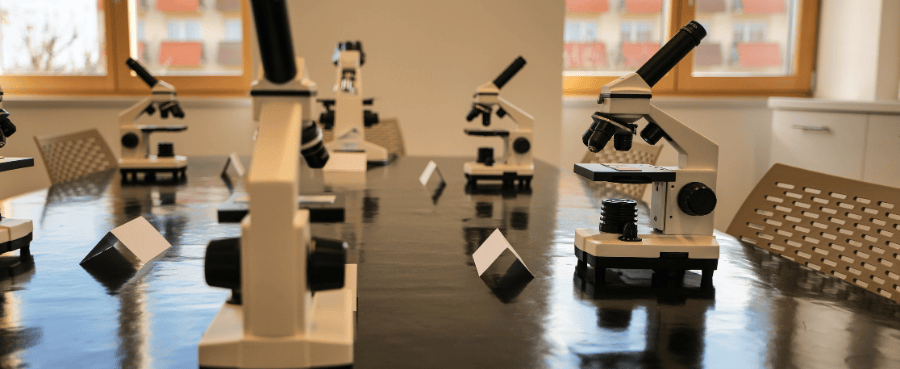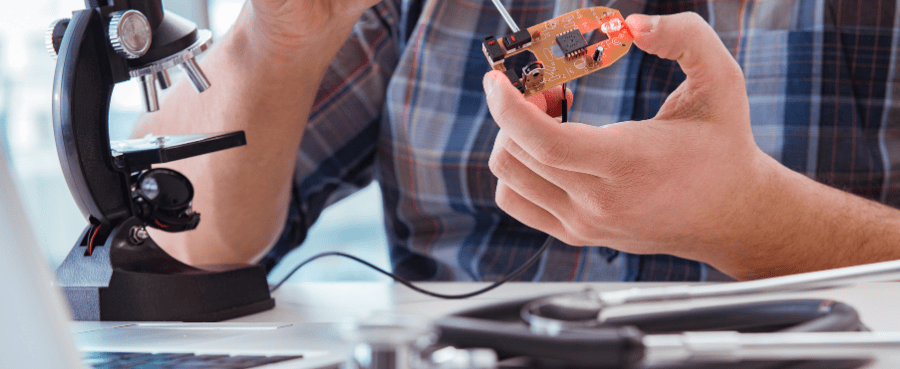In short, a 3D digital microscope captures multiple images of an object at different focal planes and compiles them into a comprehensive, entirely focused, three-dimensional image. This unique process enables you to view and analyze complex surface structures with a depth and detail that traditional flat-field microscopes cannot match. By using high-resolution optics and powerful software, it transforms a stack of flat pictures into an interactive, measurable 3D model.
This guide is designed to provide you with a comprehensive understanding of this powerful technology. We will break down not only how these systems work but also why they are becoming essential tools in so many fields.
What Is a 3D Digital Microscope and How Does It Work?
A 3D digital microscope is a system that uses a digital camera and sophisticated software to create a measurable, 3D model of a sample on a monitor. Unlike its traditional counterpart, it doesn't rely on eyepieces for direct viewing, which is the source of many of its advantages.
The Core Technology: How the "3D" Image Is Made
The magic happens through a process called focus stacking (or Z-stacking).
Think of it like taking a series of photos of a tall building. You take one photo focused on the ground floor, another on the 10th floor, another on the 20th, and so on, all the way to the roof. The microscope does this automatically, capturing multiple image "slices" at different focal planes. The software then digitally "stacks" these sharp slices together to create one perfectly focused image of the entire building.
Related Reading: What Is A Digital Microscope And How Does It Work?
Key Components of a System
A typical 3D digital microscope setup includes:
- Microscope Head: This component contains high-quality optics (lenses) and a digital camera.
- Stand with Z-axis control: A sturdy frame that allows the microscope head to move up and down with precision.
- Illumination Source: Often built-in LED ring lights or external sources to light up the sample.
- Computer and Specialized Software: The "brain" of the system that processes the images and performs analysis.

Key Features and Capabilities: What Can It Actually Do?
See Everything at Once with Extended Depth of Field (EDOF)
This is the feature that solves the "out-of-focus" problem. EDOF is the result of focus stacking, creating a single, perfectly sharp image of a tall or uneven object where every detail is in focus.
Visualize in 3D for True Surface Understanding.
The system uses the captured data to generate a 3D model of the sample's surface. You can then use your mouse to virtually tilt, rotate, and view the object from any angle on your screen, allowing you to understand its topography truly.
Measure What Matters: Height, Depth, and Volume
While 2D measurements, such as length and width, are standard, a 3D digital microscope unlocks the critical third dimension. You can accurately measure height, depth, angles, and even the volume of features on your sample, turning qualitative observation into quantitative data.
Stitch Images for a Wider View
If your sample is larger than the field of view, the image stitching function allows you to combine multiple images seamlessly. This creates a large, high-resolution map of the entire inspection area.
Key Benefits: How a 3D Digital Microscope Solves Real-World Problems
Eliminate Guesswork with Superior Image Clarity
- Benefit: Gain an entirely focused view of your entire sample. This makes it easy to confidently identify defects, analyze surface texture, and understand the spatial relationship between different features without constantly adjusting focus.
Gain Deeper Insight with Accurate 3D Measurement.
- Benefit: Move beyond simple 2D measurements to quantify height, depth, and profiles. This is crucial for quality control, failure analysis, and research, as it provides the complex data needed to make informed decisions.
Improve Workflow and Collaboration
- Benefit: Since the image is displayed on a monitor, your entire team can view it simultaneously. You can instantly capture, annotate, and share high-quality photos and reports, making collaboration seamless and efficient.
Work More Comfortably and Reduce Strain
- Benefit: Viewing on a monitor eliminates the eye, neck, and back pain that comes from hunching over traditional eyepieces for hours. This improvement in ergonomics leads to greater comfort and increased productivity.

Typical Applications: Who Relies on 3D Digital Microscopes?
3D digital microscopes are essential tools across a wide range of industries where precision, documentation, and surface topography are critical for success. They provide the quantitative data needed for process control, quality assurance, and cutting-edge research.
Automotive and Aerospace
In industries where component failure is not an option, 3D digital microscopes are used for critical inspection and analysis.
- Use Cases: Quantifying wear on engine components, analyzing the surface integrity of turbine blades, inspecting for micro-cracks in composite materials, and verifying the dimensions and finish of fuel injectors.
Electronics and Semiconductor Manufacturing
These microscopes are indispensable for process development, quality control, and failure analysis of complex micro-electronic components.
- Use Cases: Performing 3D measurement of solder paste volume and solder fillet profiles on PCBs, inspecting for defects in wire bonds and die attach, analyzing BGA (Ball Grid Array) coplanarity, and conducting topographical analysis of semiconductor wafers.
Quality Control and Failure Analysis
For manufacturing and engineering, these systems provide the definitive data needed to identify the root cause of failures and ensure products meet specifications.
- Use Cases: Performing quantitative analysis of scratches, corrosion, and wear on machined parts; conducting fractography (analysis of fracture surfaces) to determine failure mode; and creating detailed, measurable reports for ISO compliance and internal quality audits.
Materials Science and Research
Researchers rely on 3D digital microscopes to characterize the properties of novel materials and document experimental results with precision and accuracy.
- Use Cases: Quantifying surface roughness and texture of coatings and thin films, characterizing the microstructure of alloys and polymers, analyzing crystal growth, and documenting topographical changes in materials under stress or environmental testing.
Medical Device Manufacturing
In this highly regulated field, 3D digital microscopes provide the traceable, accurate measurements required for FDA and CE mark compliance.
- Use Cases: Verifying the surface smoothness of cardiovascular stents and orthopedic implants to ensure biocompatibility, inspecting the integrity of laser welds on surgical tools, and confirming the precise dimensions of critical components, such as catheters and drug-delivery systems.
How to Choose the Right 3D Digital Microscope
Define Your Primary Application
- Tip: First, determine what you need the microscope to do. Is your primary need for highly accurate measurements, simple butstraightforwardr inspection, or detailed documentation and reporting? Your answer will guide your choices.
Consider Key Specifications
- Tip: Look at the magnification range, the camera's resolution, and the intuitiveness of the software. Always request a live demo to determine if the software workflow meets your needs.
Set a Realistic Budget
- Tip: For those seeking a practical entry into this technology, Tomlov offers a specialized collection of 3D digital microscopes designed for both hobbyists and professionals. These models, such as the DM402 Pro, feature large 10.1" IPS screens for clear, ergonomic viewing and unique dual-lens systems that provide enhanced depth perception for tasks like soldering or coin inspection. Explore the collection to find a high-quality, affordable 3D Microscope that combines powerful imaging with user-friendly features.
|
Feature |
Entry-Level System |
Mid-Range System |
High-End System |
|
Z-Axis Control |
Manual |
Manual or Motorized |
Fully Motorized & Automated |
|
Measurement |
Basic 2D/3D |
Advanced 2D/3D |
High-Precision, Automated |
|
Software |
Core Features |
Advanced Analysis |
Fully Integrated, Reporting |
|
Best For |
Hobbyists, Basic Inspection |
Quality Control, R&D |
High-Throughput, Metrology |
Related Reading: How To Use a Digital Microscope

Frequently Asked Questions (FAQs)
What's the main difference between a 3D digital microscope and a stereo microscope?
A stereo microscope utilizes two separate optical paths (one for each eye) to create a 3D-like view, providing depth perception that is particularly beneficial for manual tasks such as soldering. A 3D digital microscope, however, utilizes software to create an accurate, measurable, and entirely focused 3D model. You can't perfopreciseate height measurements or obtain an entirely focused image of a tall object with a stereo microscope.
Are these microscopes difficult to learn?
They are more complex than basic microscopes, but most modern systems are designed with user-friendly software. Expect a short learning curve, but mastering the basic functions for image capture and measurement can often be accomplished in a single afternoon.
How much do they cost?
The price varies widely. Entry-level systems with manual controls might start in the low thousands, while fully automated, high-precision systems used in research and high-tech manufacturing can cost over $50,000.
What kind of computer do I need?
Because the software processes a large amount of image data, you will generally need a powerful, modern computer with a dedicated graphics card, plenty of RAM (16GB or more is recommended), and a fast processor. Always check the manufacturer's specific system requirements.
Conclusion
The 3D digital microscope is more than just a camera on a stand; it's a transformative tool for inspection, measurement, and analysis. Moving beyond the limitations of the flat, 2D world allows you to see everything in perfect focus, gather accurate 3D data, and work with greater comfort and efficiency. It provides a level of insight and confidence that can enhance the quality of your work, regardless of your field.




Hinterlasse einen Kommentar
Alle Kommentare werden vor der Veröffentlichung geprüft.
Diese Website ist durch hCaptcha geschützt und es gelten die allgemeinen Geschäftsbedingungen und Datenschutzbestimmungen von hCaptcha.